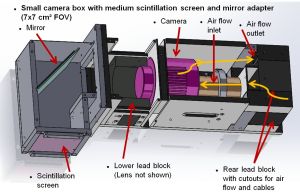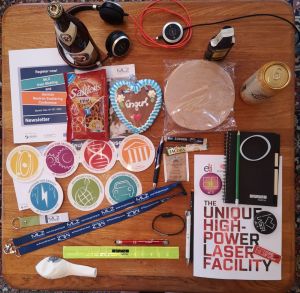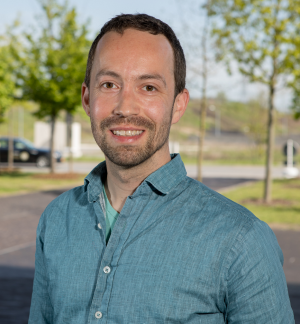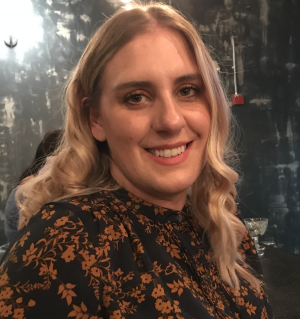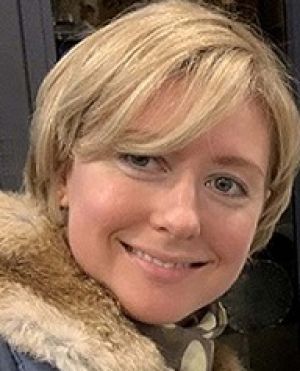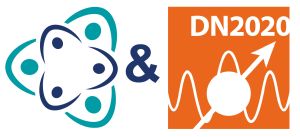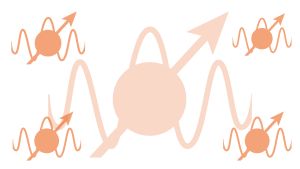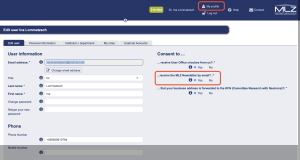MLZ is a cooperation between:
 > Technische Universität München
> Technische Universität München > Helmholtz-Zentrum Hereon
> Helmholtz-Zentrum Hereon
 > Forschungszentrum Jülich
> Forschungszentrum Jülich
MLZ is a member of:
 > LENS
> LENS > ERF-AISBL
> ERF-AISBL
MLZ on social media:

MLZ (eng)
Lichtenbergstr.1
85748 Garching
Newsletter IV/2020
Jump directly to the chapters! (and don't forget to enlarge the pictures by clicking them!)
» Editorial» Instrumentation» Let's talk about...» People» UsersEditorial
News News News
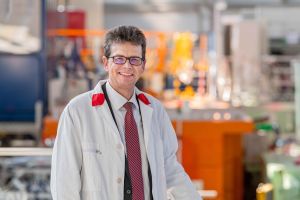
Editorial by Prof. Dr. Peter Müller-Buschbaum (Scientific Director FRM II/ Scientific Director MLZ) © A. Heddergott/ TUM
Unfortunately, news are not always good news. Looking back on the year 2020, the Covid-19 pandemic will certainly be ranked as worst news. It stopped our reactor operation after the first cycle and challenges are still ongoing. From today’s point of view, we plan a restart with neutrons in spring 2021.
The good news for this year include the inauguration of our two new buildings on-site, one funded and constructed by TUM, the other one by FZJ. These buildings provide more space for the technical workshop, additional laboratory rooms, and a significant number of office premises mitigating an urgent need. Looking forward to the next years, we will also increase our instrument suite in the Neutron Guide Hall East with the transfer of two of the Berlin instruments to Garching. The funding for this transfer has been granted by the BMBF recently.
Not to forget, you are reading our first electronic MLZ newsletter. If this development will turn out to be good or even better is up to you. Any feedback on the new format – being part of our new communication strategy – is more than welcome!
Instrumentation
» A big move: Instrument transfer from Berlin to Garching» ANTARES offers a new quadruple neutron computed tomography system
» Going East!
A big move: Instrument transfer from Berlin to Garching
In December 2019, the neutron source BER 2 at the Helmholtz-Zentrum Berlin shut down for good, and with its closure, the user programme and access to its outstanding neutron instrumentation also ceased. Two of those instruments, the cold three axis spectrometer FLEXX and the fine resolution powder diffractometer FIREPOD will now be transferred to the FRM II in Garching to start a second life of scientific use at the Heinz Maier-Leibnitz Zentrum (MLZ). The BMBF funded transfer project started in September 2020 and first preparatory work has just begun. Due to the current COVID-19 imposed circumstances, dismantling the instruments in Berlin and getting them ‘transfer ready’ will only start in 2021. The transfer of both instruments is planned to be completed in Q4 2024 – and thus, the instruments being ready for user operation at MLZ.
FLEXX
FLEXX will be transferred to the Neutron Guide Hall West to be located at the neutron guide NL6 close to the current MIRA 2 position. Within the transfer project of FLEXX, the already existing spin-echo option will be further optimized to serve as a cold Larmor diffractometer for high precision determination of interplanar spacings as needed e.g. to investigate magnetostrictive materials or materials under extreme conditions. The new area of application is also reflected in a new name – LADIFF, because the three axis functionality including the multianalyser MultiFLEXX will be available for user experiments, too.
FIREPOD
FIREPOD will find a new home in the Experimental Hall of FRM II at the beamtube SR8. FIREPOD is a fine resolution powder diffractometer for structure determination and Rietveld analysis, applicable e.g. to energy materials, correlated electron systems or complex alloys. At the new location at FRM II, the instrument will be ideally suited for parametric studies and complement the power diffractometer suite of MLZ. FIREPOD will be placed at an additional beamport at SR8, which will be located after the SPODI monochromator. To achieve enough space, the SPODI monochromator is to be shifted slightly towards the source, without changing the instrument characteristic. The thus necessary rebuild of SR8 includes the upgrade of the neutron optics of RESI/ ERWIN, respectively.
W. Lohstroh (FRM II)
ANTARES offers a new quadruple neutron computed tomography system
When neutron computed tomography was established at research sources, the first samples were medium-sized technical objects with liquids or sealants inside. The achievable resolution was in the order of a few tenths of a millimeter, and most radiography facilities were built for large objects of several tens of cm size. With improvements in beam collimation, scintillation screen and detector development, the achievable resolution today is in the order of a few ten micrometers, and users demand high-resolution examination of cm-sized objects. While camera-based detection systems can focus on a field of view of a few cm size, most of the often 10-20 cm sized neutron beam remains unused and wasted.
There have been several approaches to use more than one rotation table for several samples within the detector field of view, but this means splitting the number of pixels of the detector into several smaller fields of view for simultaneous measurements, which reduces the number of available pixels per sample and limits the achievable resolution. At ANTARES, we have therefore designed a very small and compact high-resolution detector box with the aim of putting four independent detectors into the large beam that can produce four independent high-resolution views of samples for four simultaneous CT recordings, and use precious beam time more efficiently.
Let's have a closer look!
Just have a look at the schematic drawing on the left. Lead shielding against gamma radiation from the sample and environment exists only at the front and back of the camera, sideways shielding must be stacked externally, which leaves the camera unit very small and flexible. The mirror and scintillation screen box is connected by a flange and can be swapped for different sizes, or rotated to face the other way. Water cooling was added later, since the air flow inside externally stacked shielding proved insufficient.
Fortunately, aluminium is very transparent for neutrons, so sample holders made of aluminium are nearly invisible in a radiographic image. We made sample holders out of aluminium tubes with cutout windows for inserting samples. This way, we do not need four but only two rotation axes for four independent CT recordings – two stacked detectors share one rotation table with a sample holder for two samples.
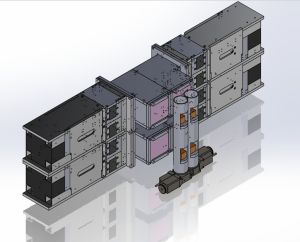
Set-up of four detectors with two rotation tables for four independent simultaneous CT recordings. © MLZ
The drawing on the right shows the schematic set-up. The only restriction is that the CT parameters for all four CT recordings must be identical. The control software will rotate both tables to a new angular position, then trigger all four cameras to record an image. The four images will then be written to the storage server.
Due to the extended shutdown of the reactor, the simultaneous set-up of the four detection systems could not be tested yet, but it will be ready as soon as the reactor resumes operation.
B. Schillinger (FRM II)
Just have a look at the gallery and find more pictures of the set-up and get a glimpse into a ladies wrist watch!
Going East!

The new interim level contains 30 tons of steel, 140 tons of concrete, is 350 m2 large, and offers a maximum 500 kg/m2 load capacity as well as space for 7 measuring cabins. © W. Schürmann/ TUM
Much has happened during the previous months in the new Neutron Guide Hall East. Since 2018, all instrument areas are connected to different media: pressure air, argon, helium and cooling water, with a total length for all pipes of more than 1000 metres. This year, a new interim level for the measuring cabins was constructed. The whole building is now connected to the FRM II power supply and no longer supplied from external sources. The new connection supplies up to 1 MW, this corresponds to an equivalent of 50 single-family houses.
For the upcoming months, project manager Linus Willerding plans the fire protection for the intermediate structure. “The cranes will arrive in early 2021“, he says. Single electrical connections for each instrument are also underway. For most of the construction works, Willerding and his team of seven colleagues in cooperation with the technical operation team need so-called modifications to the facility. They have already completed two of them in 2020 and currently six modifications are underway. Another 16 are planned for the further construction works, according to Willerding, until the hall can be finally fully used and receive neutrons by the end of 2022.
Which instruments will be involved?
- SAPHIR is already operational without neutrons and has published the first paper
- The TOPAS vacuum chamber is already in the hall
- For POWTEX, the sample chamber with doors has been delivered
- MEPHISTO will soon receive their first components like a helium medium pressure tank
- The positron source NEPOMUC has its own enclosure underneath the intermediate level: the 200 m2 are isolated and will be air-conditioned because of the temperature sensitive detectors and electronics.
A. Voit (FRM II)
Let’s talk about…
.... (involuntarily) virtual events
This time, I (IL) met my colleagues Johanna Jochum (JJ) and Christian Franz (CF). Johanna is instrument scientist at RESEDA and (together with Petr Čermák of Charles University, Prague) organized the “Czech-Bavarian MINI-SCHOOL 2020 on large scale facilities and open data” and Christian (instrument scientist at TOPAS) is one of the organizers of the weekly so-called “Neutrons in Research and Industry” seminar of TUM and FRM II.

Christian Franz at his desk at home, hosting the "Neutrons in Research and Industry" seminar. © private
IL: Nice that you meet me for a chat about your experiences as organisers of now virtual events! The school was planned as a normal school with students here in Garching as well as Prague. The weekly seminar can be called an institution: Each Monday, many MLZ colleagues rush to the Physics Department, meet the invited speaker and listen to the given talk. First of all: How did you switch to virtual?
CF: We use ZOOM for our talks now but we still try to stick to the format of an internal institute seminar, thus we don’t record and/ or stream.
JJ: We used the same for the talks of the school and also for the guided tour of the FRM II: I connected my phone, strapped it to my chest, switched on the camera and wandered around in the Neutron Guide Hall West, showing instruments, telling anecdotes, and chatting to some colleagues whom I could motivate to join.
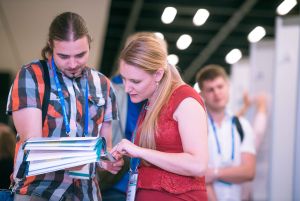
Johanna Jochum and Petr Čermák already planning the MINI-SCHOOL during the ECNS 2019 at St. Petersburg (without masks and safety distance before the virus hit the world). © ECNS 2019
IL: That’s a cool idea! I hope, nobody became seasick due to your motions… But what about the social factor? I always feel a bit inhibited to interact with others in a vicon.
JJ: We just gave it a try and started with a social event: First, riddles have to be solved in break-out rooms to break the ice. That was quite funny, but afterwards we met at wonder.me, where each participant has an avatar and you can move around and chat with the others – it is a kind of a virtual bar. That was a real success!
CF: We learned from last term (our first virtual one), and now try to establish discussion rounds with the speaker. We invite some people to join the room already before the talk. So, they get the opportunity to chat a little bit with the speaker. They will also switch on their cameras during the talk. We all know how annoying it is to speak to all those black tiles, without any visible audience and feedback!
IL: Yes that is right: You always feel like an idiot when sitting before your screen and talking to yourself! How do people respond to your efforts?
CF: Really good! On average, we have about 35 participants, that is the usual number we also had before. But during some talks, we had between 60 and 70! Going virtual means also that we now can invite also speakers from USA and Australia – the feedback from them is always positive when we ask for a talk.
JJ: The students adjusted perfectly to the new situation. They enjoyed the evening on wonder.me that much that we re-activated the canceled conference dinner and met there again!
IL: And what was the craziest thing that could only happen because of the online format?
CF: Once we had to deal with a Zoom bomber – but fortunately he left quickly.
JJ: Since we didn’t need to spend any more money on hotels and travel, we decided to put together a nice package for the students, including snacks and drinks from Prague and Munich. But the package I sent to Prague (including information about the FRM II, Bavarian Beer, gingerbread hearts, pretzls..) got LOST by the DHL… and has not been found yet :(
IL: Thank you for sharing your experiences!
compiled by I. Lommatzsch (JCNS)
People
Newly arrived
Philipp Bender
I am a new instrument scientist at the resonance spin echo spectrometer RESEDA, and I hope to further establish it as a worldclass instrument for neutron spin-echo experiments (in particular MIEZE-SANS) and to build great collaborations with other colleagues at the MLZ.Before, I worked as a postdoctoral researcher in Germany (Saarland University), Spain (Universidad de Cantabria) and recently Luxembourg (University of Luxembourg). My main research interests are the application of small-angle neutron scattering techniques for the characterization of magnetic nanostructured materials. I am especially interested in magnetic nanoparticles with a special focus on their potential biomedical applications.
If you like to learn more about “relating magnetic properties and high hyperthermia performance of iron oxide nanoflowers”: P. Bender et al., J. Phys. Chem. C 5 (2018) 3068-3077https://doi.org/10.1021/acs.jpcc.7b11255
Marcella Berg
I am hired as the second instrument scientist on the back scattering spectrometer SPHERES. Beside working as local contact I will continue my research on biomass and sustainable energy. I started working in that field at ORNL, where I was hosted after my PhD work at the Niels Bohr Institut, University of Copenhagen. There, my main focus was on the understanding of nano-scale dynamics of an aqueous solution used to form Glass Ionomer Cements and its correlation with the setting process. I combined quasi-elastic neutron scattering (QENS), inelastic neutron scattering (INS), and calorimetry to understand the nano-scale dynamics in the materials.
At MLZ, I am especially looking forward to starting new collaborations, where I can continue combining neutron scattering with computational techniques.
Margarita Fomina
I joined JCNS-4 as a second instrument scientist at the neutron spin-echo spectrometer J-NSE. I have been using neutron scattering (particularly, quasi-elastic, inelastic, small-angle) throughout my postdoctoral and doctoral research conducted in different countries across the world. Together with Olaf Holderer, I am going to support users at J-NSE, work on the instrument improvement and advancement of the sample environment, as well as collaborate on various research topics.
My scientific interests in different materials include lipids, proteins, carbohydrates, nanomaterials, ionic liquids, and many others. I’m looking forward to conducting exciting research at the MLZ campus and beyond.
Zakaria Mahhouti
In December of 2019, I received my Doctor (Ph.D.) in condensed matter physics from the University of Picardie Jules Verne (France) in collaboration with Mohamed V University (Morocco). My dissertation focussed on the synthesis and characterization of functional magnetic nanomaterials (both magnetic nanoparticles and nanorods). After successfully defending my Ph.D., I started my career as a second instrument scientist at JCNS and I am now a part of the small angle neutron scattering (SANS) team at KWS-1.
My tasks are conducting experiments as well as deepen my own research in the field of magnetic nanoparticles and nanostructures.
Furkan Erdem
I am the new face in the MLZ User Office and will take care of the daily business there together with Ramona Bucher. Starting on Dec 7th, I just came at the right time to dive into the MLZ User Meeting and DN2020. I strengthened the team in the conference office and thus already got in touch with “my first users”!
Before, I got an education as an industrial clerk at a big automobile manufacturer. I am now looking forward to learn a lot before user operation starts again and work at the User Office returns to a kind of normality.
Users
» MLZ User Meeting and DN2020: Meetings without meeting....» The new digital MLZ newsletter
» The first mandate period of the MLZ User Committee
» II. MLZ User Committee elected!
MLZ User Meeting and DN2020: Meetings without meeting....
Under normal conditions, the 405 registered participants of the MLZ User Meeting and the DN2020 would have met at a conference hotel in Munich downtown and enjoyed discussions, networking, and just chatting with old friends during a poster session with beer and pretzels between Dec. 8th-10th. Unfortunately, due to the ongoing corona pandemic, this was impossible. But there was no thought of a cancellation and therefore, MLZ and the KFN (Komitee für Forschung mit Neutronen), who is the patron of the DN, decided to switch to purely virtual events. And thus, a total of 96 talks were held via ZOOM during these three days.
On the first afternoon of the User Meeting, participants gathered for the six parallel workshops of the MLZ Science Groups Materials Science, Soft Matter, Quantum Phenomena, Structure Research, Neutron Methods, and Nuclear, Particle, and Astrophysics. They had to choose between a lot of thrilling talks dealing with so many different topics: Zoe Fisher (ESS) hunted for enzyme isoform specific ligand binding, Steffen Neumeier (FAU Erlangen) explained, how advanced characterizing techniques help to develop novel Co-based superalloys, Martin Fertl (JGU Mainz) discussed cyclotron radiation emission spectroscopy in the context of precision 𝛽−decay experiments – and there was so much more!
Wednesday morning offered the plenary talks of the MLZ User Meeting. First, MLZ Director Peter Müller-Buschbaum looked back on 2020 here at Garching and explained how the MLZ prepares for mail-in/ remote experiments: an important development in the scope of the pandemic situation. Afterwards, Susann Schorr (HZB) talked about insights into structural disorder in photovoltaic absorber materials using neutron diffraction. Akira Uedono (University of Tsukuba) presented the usefulness of positron annihilation spectroscopy, and finally, Julian Oberdisse (Laboratoire Charles Coulomb) answered the question “How much information is in my scattering data?”. The report on the work of the MLZ User Committee by its chair Adrian Rennie (University of Uppsala) closed the talks of the User Meeting.
After a short break, the DN2020 started. Traditionally, the Wolfram Prandtl Prize is awarded during the DN – this was also the case this time: The awardee 2020 was Sabrina Disch of University of Cologne for her research results on magnetic nanoparticles that she presented in her awardee lecture afterwards (don’t miss our article about this!).
On Wednesday afternoon, the poster session started. 159 posters waited for online visitors. In the beginning, some server problems disturbed the experience but fortunately they could be solved on short time notice. After this stumbling start, visitors went into the online rooms and discussions at the posters picked up speed. Late afternoon saw many participants using the rooms for chatting with colleagues.
The third day was then dedicated to the DN2020 : It started with the plenary talks of Markus Appel (ILL), Thomas Hellweg (Universität Bielefeld), Nathalie Kunkel (Universität Göttingen),Bastian Märkisch (TUM), Alexander A. Tsirlin, (Universität Augsburg), and Martin Weik (IBS). After a short break, the participants spread among three parallel sessions, before the event was closed with the presentation of the 12th KFN, that had been elected shortly before. The 11th KFN chair Astrid Schneidewind (FZJ) handed over her position to Frank Schreiber (Universität Tübingen). (Read also the detailed event report!)
Because this was the first big virtual event the MLZ organized, we asked the participants to complete a survey. We are happy that so many took this opportunity! We learned that the talks were very well received (from both the presenters’ and listeners’ side) but about the poster session, opinions were divided… We got a lot of ideas how to improve such an event in the future and are thankful for this.
We all missed the same thing: The face-to-face meeting, the socialising, the little chats with people one meets by accident. Therefore we hope for better circumstances on the next MLZ User Meeting on Dec. 6th and 07th, 2021!
I. Lommatzsch (JCNS)
The new digital MLZ newsletter
Late autumn 2008 saw the idea of a regular kind of magazine and we called it “FRM II news” – a name we changed after the inauguration of the MLZ. For 24 issues (that means twelve years!) we brainstormed twice a year, searched for thrilling topics, edited and typesetted the articles delivered by colleagues carefully, worked on the pictures, and finally prepared everything for printing. And when the pallet arrived at Garching, we labelled nearly 1000 copies and sent them to our users all over the world.
After several layout and format relaunches, we now decided that it is time to go purely digital. A paper version seems to be a little bit outdated in a world where most of us are permanently online and reading ebooks instead of beautiful leather bound tomes. Becoming also shorter, we like to inform you more often – the newsletter is planned to send out four times a year! You will read articles written especially for the newsletter, find links to user-related news on the MLZ web page, and get important dates as well.
We are just starting this project and looking forward to new ideas and how this project will develop! In case you have any comment, it is higly welcome at useroffice@mlz-garching.de!
How to become a subscriber?
This first issue is sent to all users registered in our User Office software GhOST – but we will do this only once in order to introduce the newsletter!
In case you like to recieve it further, please login at GhOST and subscribe for it in your GhOST profile. There, you can also unsubscribe anytime.
If you are no user and thus have no GhOST account, please contact the MLZ User Office!
I. Lommatzsch (JCNS)
The first mandate period of the MLZ User Committee
The mandate period of the first User Committee at MLZ is drawing to a close as I write these remarks. There will be opportunity for interaction at the User Meeting in December 2020, but it is useful to provide some more information on what has been done. There have been 19 meetings in the last three years. These have been mostly video meetings held at intervals of about two months. Once a year we have arranged to gather for a face-to-face meeting. This is also an opportunity to discuss issues that arise with the Scientific Directors.
To speak on behalf of the user community requires that we have information about any difficulties and to pass on ideas and suggestions that arise when making experiments. Often people do not want to complain personally. If an issue arises repeatedly, it is useful to identify the problem so that it can be addressed generally. Providing relevant information to the user committee can help with both these points – any information is passed in anonymous form and the individual names of people providing feedback are not disclosed to anyone at MLZ. We urge everyone to continue to make comments. The contact details of the user committee are available at the User Committee webpage.
Please get in touch or keep in touch!
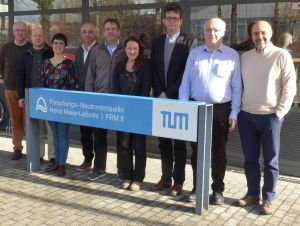
The first MLZ User Committee at Garching in January 2019. From left to right: David Keeble, Jens Gibmeier, Sophie Combet, Luigi Paduano, Rainer Newa (observer of KFN), Diana Quintero-Castro, Peter Müller-Buschbaum (Scientific director MLZ), Adrian Rennie (chair), Flavio Carsughi (MLZ User Office). © W. Schürmann/ TUM
It may be interesting to know a little about how many comments are received and what issues are raised with us. Certainly, the most frequent question is about when MLZ will be operating and this reflects the difficulties over recent years with the fuel cycle and with operations under the covid-19 pandemic. The question frequently arises together with a comment that the user is anxious to resume use of the facility that they find essential for their research. Apart from this, comments arise either when the reminder is sent to users at the end of an operating cycle or when members of the committee meet other users in person. This second route has obviously reduced in recent months. So far this year, about 10 specific comments were raised and the themes of working space during experiments are prominent. Better communication about MLZ is clearly beneficial and the User Committee has been striving to achieve this.
This will be the last time that I write as chair of the User Committee – the election of a new committee is underway. I urge you to vote. I decided that it is probably good to have some turn-over of membership and am not standing for re-election. My enthusiasm for research at MLZ and the development of the facility remains, of course, undiminished.
Finally, I wish users, MLZ staff and management well for the coming holiday season and extend best wishes for a successful and healthy New Year.
A. Rennie (University of Uppsala)
II. MLZ User Committee elected!
With 2020 coming to an end, we have to wave farewell to the I. MLZ User Committee that had served between 2018 and 2020 and paved the ground for the work of the following committees.
Its dedicated work is very valuable and helps us to provide better service to our users by offering them the opportunity to give any kind of feedback anonymously via their elected representatives.
Between Nov. 18th and Dec. 15th, 2020, the election of the second MLZ User Committee took place. Twelve users stood up for it and could be voted via an online election service provider. We like to thank all users who did this!
The MLZ User Committee 2021-2023
We are looking forward to work with the II. MLZ User Committee
- Tommy Nylander, Lund University
- Andrea Scotti, RWTH Aachen
- Ana Brás Würschig, University of Cologne
- Sandra Cabeza, ILL
- Jens Gibmeier, KIT
I. Lommatzsch (JCNS)
Welcome to the MLZ Newsletter!
The MLZ Newsletter is sent directly to your inbox. All our users are invited to subscribe to it via GhOST!
You aren’t a scientific user but interested? Then just send an email to the MLZ User Office!
MLZ is a cooperation between:
 > Technische Universität München
> Technische Universität München > Helmholtz-Zentrum Hereon
> Helmholtz-Zentrum Hereon
 > Forschungszentrum Jülich
> Forschungszentrum Jülich
MLZ is a member of:
 > LENS
> LENS > ERF-AISBL
> ERF-AISBL
MLZ on social media:





